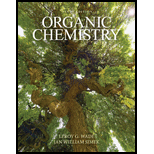
(a)
Interpretation:
The synthesis of given compound with the use of cyclopentanol, alcohols that have no more than four carbon atoms as starting materials and any common reagents and solvents is to be stated.
Concept introduction:
The sulphuric acid catalyzed dehydration reaction is used to convert alcohols into respective
(b)
Interpretation:
The synthesis of given compound with the use of cyclopentanol, alcohols that have no more than four carbon atoms as starting materials and any common reagents and solvents is to be stated.
Concept introduction:
The reaction of secondary alcohols with PCC leads to the formation of
(c)
Interpretation:
The synthesis of given compound with the use of cyclopentanol, alcohols that have no more than four carbon atoms as starting materials and any common reagents and solvents is to be stated.
Concept introduction:
The reaction of secondary alcohols with PCC leads to the formation of ketone. The Wittig reaction of ketone through phosphorous ylides leads to the addition of double bond (alkene). The reaction of an alkene with
(d)
Interpretation:
The synthesis of given compound with the use of cyclopentanol, alcohols that have no more than four carbon atoms as starting materials and any common reagents and solvents is to be stated.
Concept introduction:
The reaction of secondary alcohols with
The conversion of an alcohol into an alkyl bromide is done by
The reaction of Grignard reagent with ketone yields an alcohol. The reaction of an alcohol with
(e)
Interpretation:
The synthesis of given compound with the use of cyclopentanol, alcohols that have no more than four carbon atoms as starting materials and any common reagents and solvents is to be stated.
Concept introduction:
The conversion of an alcohol into an alkyl bromide is done by
The reaction of an alcohol with
(f)
Interpretation:
The synthesis of given compound with the use of cyclopentanol, alcohols that have no more than four carbon atoms as starting materials and any common reagents and solvents is to be stated.
Concept introduction:
The reaction of secondary alcohols with PCC leads to the formation of ketone. The conversion of an alcohol into an alkyl iodide is done by
Want to see the full answer?
Check out a sample textbook solution
Chapter 11 Solutions
Pearson eText Organic Chemistry -- Instant Access (Pearson+)
- Can I get helpp drawing my arrowsarrow_forwardWhich of the m/z values corresponds to the base peak in the mass spectrum shown? 100 80 A. 45 B. 44 C. 29 D. 15 Intensity 20 0 10 20 30 40 B- m/z -8 50 E. 30 Which of the m/z values correspond to the molecular ion for the compound shown? A. 18 B. 82 OH C. 100 D. 102 E. 103arrow_forwardCan someone help me with drawing my arrows.arrow_forward
- I'm having trouble with converting lewis diagrams into VSEPR diagrams. I currently have this example of C2BrCl3 which I want to turn into a lewis structure, but I'm not sure what steps I need to do in order to do so. I have the table written down, however, there's two central atoms so what would I do? There seems to be 4 electron domains on the carbon atom and no lone pairs so it would seem like this shape would be tetrahedral. Here's what I have now. Thanks!arrow_forwardWe discussed the solid phase resin using in peptide synthesis. Provide a mechanism, for its formation. DRAW THE MECHANISM.arrow_forwardPlease help. Every time I've asked an expert in the past, it's been wrong :(arrow_forward
 Chemistry & Chemical ReactivityChemistryISBN:9781337399074Author:John C. Kotz, Paul M. Treichel, John Townsend, David TreichelPublisher:Cengage Learning
Chemistry & Chemical ReactivityChemistryISBN:9781337399074Author:John C. Kotz, Paul M. Treichel, John Townsend, David TreichelPublisher:Cengage Learning Chemistry & Chemical ReactivityChemistryISBN:9781133949640Author:John C. Kotz, Paul M. Treichel, John Townsend, David TreichelPublisher:Cengage Learning
Chemistry & Chemical ReactivityChemistryISBN:9781133949640Author:John C. Kotz, Paul M. Treichel, John Townsend, David TreichelPublisher:Cengage Learning

